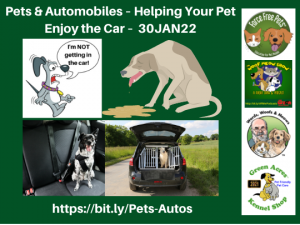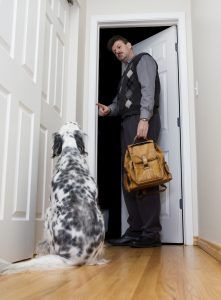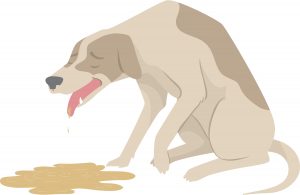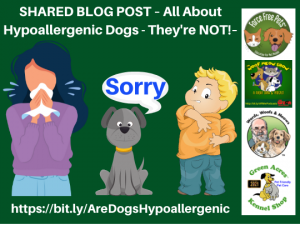 < A version of this article was published in the January and February 2022 issues of Downeast Dog News>
< A version of this article was published in the January and February 2022 issues of Downeast Dog News>
< Updated 30JAN22 >
< A short link for this page – https://bit.ly/Pets-Autos >
Cars, trucks, mini-vans, basically any automobile are often as much a part of our pets’ lives as they are ours. It’s how we brought them home the first time and transport them to all types of activities. We have all known someone who has a dog that the mere mention of “car ride” has the dog leaping in ecstasy. However, some dogs are or become terrified of riding in a moving vehicle. Some cats enjoy car rides, but many find the crate and car a predictor of getting sick or a trip to the vet.
Automobile Safety for Pets
We are responsible for the safety of our pets. Pets need to be secured in a vehicle when it is in motion for their safety and our own. A loose pet can become a distraction to the driver. A pet in the car’s front seat is unlikely to survive if the airbag discharges in an accident. An unsecured pet riding in a vehicle is more likely to become seriously injured. It also has great potential to hurt passengers if they become a fast-moving projectile due to a sudden stop. Even if a pet is uninjured in an accident, it is possible that they will be so terrified they will frantically try to escape, which itself can result in injury or death. Dogs have even been known to deter emergency personnel from rescuing injured people.
airbag discharges in an accident. An unsecured pet riding in a vehicle is more likely to become seriously injured. It also has great potential to hurt passengers if they become a fast-moving projectile due to a sudden stop. Even if a pet is uninjured in an accident, it is possible that they will be so terrified they will frantically try to escape, which itself can result in injury or death. Dogs have even been known to deter emergency personnel from rescuing injured people.
An article about car safety harnesses in the Whole Dog Journal, [Car Safety Harness Recommendation, updated 3/21/19], discusses a Boxer named Ruby riding in a car unrestrained when the vehicle was in an accident. Ruby survived but “…suffered a spinal cord injury and mild brain injury.” Ruby also required months of intensive rehab, costing over $9000.
One option for securing a pet in a vehicle is a hard-sided crate of the type used for air transport. The crate should be just big enough for your pet to stand up and lie down. A separate crate should be used for each pet. It would be best if you secure the crate to the vehicle chassis in a manner such that it cannot break loose in the event of an accident. An unsecured crate can become a dangerous projectile.
For a crate to effectively keep your pet safe and secure in your vehicle, your pet must be comfortable in their crate. Unfortunately, some pets find a crate  stressful, in which case you will need to patiently help them learn that a crate is a safe and comfortable place. These two articles can help you through the process; Dogs – Crate Habituation to Reduce Anxiety – http://bit.ly/CrateHabituation and Cats – Make Your Life Easier – Get Your Cat to Love Their Carrier – http://bit.ly/Cats-Carriers.
stressful, in which case you will need to patiently help them learn that a crate is a safe and comfortable place. These two articles can help you through the process; Dogs – Crate Habituation to Reduce Anxiety – http://bit.ly/CrateHabituation and Cats – Make Your Life Easier – Get Your Cat to Love Their Carrier – http://bit.ly/Cats-Carriers.
A gate or barrier is another option for securing a pet in a vehicle. However, for these to provide the safety necessary in an accident, they must be attached to the vehicle chassis so they cannot break free. While a barrier might keep passengers safe, it is no guarantee the pet will survive the crash.
Many people confine their dogs to the backseat of their car with a special harness or seatbelt made especially for dogs. Unfortunately, many of these products may not protect your dog in a crash, giving you a false sense of security. Only three such harnesses have passed the rigorous crash test standards of the Center for Pet Safety (CPS) [https://www.centerforpetsafety.org/] You can find a list of harnesses, carriers, and crates that are CPS Certified at https://www.centerforpetsafety.org/cps-certified/
While a CPS Certified harness can be an excellent option, recognize that your dog may not automatically enjoy being harnessed in the car. A reward-based dog trainer can help you slowly acclimate your dog to wearing such a harness in the car. FMI – How to Select A Dog Trainer – http://bit.ly/HowToSelectADogTrainer.
Does Your Pet Need to Go With You?
Most of us rarely take our cats for a ride because of most cats’ inherent dislike of travel. On the other hand, many of us love our dogs’ company, and the dog often loves the adventure of a ride. However, suppose you will need to leave your dog alone in the vehicle at any time. In that case, I encourage you to ask yourself if having the dog with you is necessary.
travel. On the other hand, many of us love our dogs’ company, and the dog often loves the adventure of a ride. However, suppose you will need to leave your dog alone in the vehicle at any time. In that case, I encourage you to ask yourself if having the dog with you is necessary.
Unless the trip is specifically for the dog, a visit to daycare or the dog park, a hiking adventure appropriate for the dog, a trip to the veterinarian, or something else where the dog’s presence is required, I encourage you to consider leaving the dog at home. When we leave a dog alone in a vehicle, we need to worry about them; overheating, getting too cold, becoming anxious and frantically trying to escape, being stolen, or being teased by uncaring people. More than one person has told me how they caught a person taunting their dog when they left their dog alone in the car. After this, the dog behaved aggressively anytime anyone approached the vehicle. Another person told me they left their dog alone in the car for only a brief moment. However, it was enough time for the dog to bite a child when they stuck their little hand in through the open window. I love having Muppy with me, but if there is any chance I might need to leave her alone in the car, she stays home.
Aversion and Motion Sickness
A dog may suddenly refuse to get in the car for several reasons. The vehicle may have become a predictor of something unpleasant such as a trip to the  veterinarian. Or perhaps the dog was in the car during a traumatic event such as a crash or a thunderstorm. If the dog was injured getting in or out of a vehicle, they might also become afraid of the car. Even having an angry conversation with someone over your phone while the dog is in the vehicle may cause an aversion to being in the car.
veterinarian. Or perhaps the dog was in the car during a traumatic event such as a crash or a thunderstorm. If the dog was injured getting in or out of a vehicle, they might also become afraid of the car. Even having an angry conversation with someone over your phone while the dog is in the vehicle may cause an aversion to being in the car.
Nausea due to motion sickness is one of the biggest reasons dogs learn to dislike traveling. If the pet has little experience traveling, they may not be comfortable in motion, especially if confined in a crate or unable to see where they are going. Since you control the car’s movement, how you drive or where you drive may be a factor. A queasy tummy may not be related to movement but may be triggered by something the dog ate. However, since the sick feeling started in the car, the dog may associate feeling queasy with the vehicle and not what they ate. Medical conditions such as an inner-ear problem may also cause nausea. However, no matter the cause, anything that causes physical or emotional pain or discomfort is likely to be remembered and is unlikely to resolve on its own. I encourage you to speak to your veterinarian or a credentialed animal behavior consultant as soon as possible for the sake of your pet.
a factor. A queasy tummy may not be related to movement but may be triggered by something the dog ate. However, since the sick feeling started in the car, the dog may associate feeling queasy with the vehicle and not what they ate. Medical conditions such as an inner-ear problem may also cause nausea. However, no matter the cause, anything that causes physical or emotional pain or discomfort is likely to be remembered and is unlikely to resolve on its own. I encourage you to speak to your veterinarian or a credentialed animal behavior consultant as soon as possible for the sake of your pet.
Two of my nine dogs went through periods of being uncomfortable in the car. When Tikken was a puppy, I started taking her on frequent short trips to acclimate her to travel. She was transported in a crate to keep her safe. These included a weekly trip to her vet for what I called a “happy visit,” where we walked in, I gave her a few treats, and then we left. One day I took her out of the crate when we got home, and I noticed she had drooled so profusely that her chest was soaked. The next time I tried to get her in the car, she sat down 20 feet away and refused to get any closer. The excessive drooling was a sign of nausea, and Tikken made it clear she did not want to get in the car again. I helped Tikken  learn that the vehicle was safe by stopping all travel until I successfully desensitized and counter conditioned her to like the car. A couple of months later, we took a 10-hour trip without incident.
learn that the vehicle was safe by stopping all travel until I successfully desensitized and counter conditioned her to like the car. A couple of months later, we took a 10-hour trip without incident.
My second dog to have issues in the car is my current dog, Muppy. The day we drove home with her, for three-plus hours, was without incident. However, soon after, she would occasionally vomit in the car about one out of every ten car rides. Fortunately, Muppy never became hesitant about getting in the vehicle. Still, her obvious discomfort and the profuse amounts of vomit motivated me to get her feeling comfortable. I was able to do so with some anti-nausea products. However, due to the unpredictability of her getting sick, it took a couple of years to figure it out.
If your dog is experiencing excessive drooling, vomiting, or diarrhea, specific to being in a moving vehicle, make an appointment with your veterinarian so that they can rule out any medical causes and prescribe any necessary medications.
How to tell if your dog is uncomfortable in the car
- Your dog is exhibiting signs of stress and discomfort in or around the vehicle ( FMI – http://bit.ly/DogsSignsofFear
- Your dog refuses to get in the car. Please understand making them get into the car will only make them more fearful of the car and you. It is not a solution.
- Your dog is smacking or licking its lips or drooling excessively, indicating they may feel nauseous or anxious.
- Your dog is vomiting or has diarrhea when in the car; both can be a sign of nausea or anxiety.
Things that may help alleviate nausea and anxiety
- Limit trips to only those that are necessary until the issue is resolved.
- Withhold food and treats at least 12-hours before necessary travel.
- Practice very short trips in the vehicle; 30ft, 60ft, 100ft, increasing in small increments. You might want to consult with a credentialed pet behavior consultant to assist you with developing a desensitization protocol.
- Treat nausea and, if necessary, anxiety.
- Over the counter treatments (No Prescription Required)
- Ginger helps relieve nausea. The easiest way to see if it helps your dog is to get some gingersnap cookies. Just make sure they contain real ginger and do not contain xylitol. Give a cookie about 30-minutes before travel.
- CBD can relieve both anxiety and, in some cases, nausea. It is one of the things I use with Muppy. Just be careful as there is a wide range of CBD products, and not all of them are of equal quality. ( FMI – http://bit.ly/BLOG-Hemp-CBD-PRO-for-pets )
- Adaptil – This is a pheromone that can help alleviate anxiety. It is available as a spray and a collar.
- Lavender Essential Oil – Lavender can have a calmative effect. Still, just as with CBD, there are many Lavender products, and they are not all of the same grade and quality.
- Bach Rescue Remedy – Rescue Remedy® is a combination flower remedy formula explicitly created for addressing stress in emergencies or crises. I have used it for over 20 years in a wide variety of applications. ( FMI – http://bit.ly/Bach-RescueRemedy )
- Homeopathic Remedies – While many homeopathic medications do not require a prescription, I recommend that you work with a Homeopathic Veterinarian if you are not knowledgeable in this area. Some remedies can be beneficial in treating nausea and motion sickness. One was very helpful with Muppy. Dr. Herman, who also writes a column for Down East Dogs News, is knowledgeable about using homeopathic remedies with pets.
- Prescription medications – (Must be prescribed by a veterinarian). Only treating nausea may be enough, but symptoms of nausea may predict anxiety, so an anti-anxiety medication may also be in order. Common medications prescribed by veterinarians for these conditions include:
- for nausea – Cerenia®, Antivert®, and Bonine®
- for anxiety – Alprazolam (Xanax®), trazodone (Desyrel®)
- Please do not use any prescription medication with your pet without first discussing it with your veterinarian.
- Behavior Modification – A desensitization and counterconditioning protocol, such as I used with Tikken, may be helpful or even necessary to get the dog to tolerate or enjoy the car after a bad experience. A credentialed dog behavior consultant or Veterinary Behaviorist such as DEDN columnist Dr. Christine Calder can help. ( FMI – http://bit.ly/WWM-Trainer-Behaviorist )
- Over the counter treatments (No Prescription Required)
Recommended Resources
Articles on Don’s Blog
( http://www.words-woofs-meows.com )
Dogs – Crate Habituation to Reduce Anxiety – http://bit.ly/CrateHabituation
Cats – Make Your Life Easier – Get Your Cat to Love Their Carrier – http://bit.ly/Cats-Carriers.
How to Choose A Dog Trainer – http://bit.ly/HowToSelectADogTrainer
How Can I Tell When My Dog Is Anxious or Fearful? – http://bit.ly/DogsSignsofFear
How Hemp-Derived Phytocannabinoid Nutraceuticals May Help Your Pets – http://bit.ly/BLOG-Hemp-CBD-PRO-for-pets
Bach Flower Remedies – Bach Rescue Remedy® – http://bit.ly/Bach-RescueRemedy
Do I Need a Dog Trainer or a “Behaviorist”? – http://bit.ly/WWM-Trainer-Behaviorist
Contact Information for Dr. Herman & Dr. Calder
Dr. Judy Herman
Animal Wellness Center
95 Northern Ave., Augusta ME
207-623-1177
http://www.judithhermandvm.com/
Dr. Christine Calder
Calder Veterinary Behavior Services
207-298-4375
www.caldervbs.com
________________________________________________________________________
Don Hanson is the co-owner of the Green Acres Kennel Shop ( greenacreskennel.com ) in Bangor, Maine, where he has been helping people with their pets since 1995. He is also the founder of ForceFreePets.com, an online educational resource for people with dogs and cats. Don is a Bach Foundation Registered Animal Practitioner (BFRAP), Certified Dog Behavior Consultant (CDBC), Associate Certified Cat Behavior Consultant (ACCBC), and a Certified Professional Dog Trainer (CPDT-KA). He is a member of the Pet Professional Guild (PPG), where he serves on the Board of Directors and Steering Committee and chairs the Advocacy Committee and The Shock-Free Coalition ( shockfree.org ). In addition, Don produces and co-hosts a podcast, The Woof Meow Show, available at http://bit.ly/WfMwPodcasts/, the Apple Podcast app, and Don’s blog: www.words-woofs-meows.com. The opinions in this post are those of Don Hanson.
©23JAN22, Donald J. Hanson, All Rights Reserved
< Click for Copyright and Use Policy >


